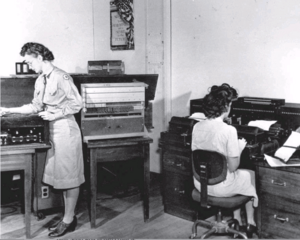Genevieve Grotjan Feinstein facts for kids
Quick facts for kids
Genevieve Grotjan Feinstein
|
|
|---|---|
 |
|
| Born |
Genevieve Marie Grotjan
April 30, 1913 |
| Died | August 10, 2006 (aged 93) |
| Citizenship | American |
| Known for | Deciphering the Purple machine |
| Spouse(s) | Hyman Feinstein |
| Scientific career | |
| Fields | Mathematics Cryptanalysis |
| Institutions | Signals Intelligence Service |
Genevieve Marie Grotjan Feinstein (born April 30, 1913 – died August 10, 2006) was a brilliant American mathematician. She was also a cryptanalyst, which means she was a codebreaker. She worked for the Signals Intelligence Service during World War II.
Genevieve played a very important part in breaking a secret Japanese code. This code was made by a machine called Purple. Later, she also worked on another secret project called the Venona project during the Cold War.
Contents
Genevieve's Amazing Career as a Codebreaker
Genevieve Grotjan loved math from a young age. She dreamed of becoming a math teacher. She graduated from the University at Buffalo in 1936 with a math degree. She earned top honors, called summa cum laude.
How Did Genevieve Start Codebreaking?
After college, Genevieve couldn't find a teaching job. So, she worked as a clerk. In 1939, she took a special math test for government jobs. She scored very high! This caught the eye of William F. Friedman, a famous codebreaker. He hired her to work as a junior cryptanalyst for the Army's Signals Intelligence Service (SIS).
Cracking the Purple Code
For about 18 months, Genevieve worked with other SIS codebreakers. Their mission was to understand the secret code used by the Japanese Purple machine. This machine created very complex codes.
On September 20, 1940, Genevieve made a huge discovery. She found a repeating pattern in the Purple code. This was a major breakthrough! Her discovery helped the SIS build their own machine. This new machine could read almost all messages sent by the Japanese government. These messages gave the Allies important information during World War II. For example, reports from the Japanese ambassador in Berlin, Hiroshi Oshima, gave clues about Axis plans.
Awards and Later Work
In 1946, Genevieve received a special award. It was called the Exceptional Civilian Service Award. This award recognized her important work during the war.
Later, she joined the Venona project. This project aimed to decode secret messages from the Soviet Union's spy agencies, the KGB and GRU. In November 1944, she made another big discovery. She found a way to tell when a secret code, called a one-time pad, was used incorrectly. This helped American codebreakers a lot.
Genevieve continued working at the SIS after World War II. But she resigned in 1947. After leaving government work, she became a math professor. She taught at George Mason University.
Genevieve's Personal Life
Genevieve Grotjan married Hyman Feinstein in 1943. Hyman was a chemist. They had a son named Ellis. Sadly, Ellis passed away at age 22. Genevieve Grotjan Feinstein died in 2006.
Genevieve's Lasting Impact
Genevieve Feinstein's work on the Purple machine was incredibly important. The Encyclopedia of American Women at War called it "one of the greatest achievements in the history of U.S. codebreaking."
In 2010, she was honored after her death. She was added to the NSA Hall of Honor. This is a special place for people who made big contributions to codebreaking. An award for cryptology was also created in her name at George Mason University. In 2018, the University at Buffalo called her "An American Hero."


